|
Imperial German Navy
Other Ranks Uniforms
|
 |
 |
 |
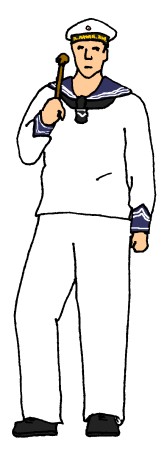 |
|
Figure 1
Matrose
S-90 Torpedo Boat
Tsingtao c1914
Blue Uniform |
Figure 2
Artillerie
Ober-Matrose
Kiaochow Naval Artillery
Tsingtao 1914
Blue Uniform |
Figure 3
Matrose
SMS Jaguar
Japan c1917
White Uniform |
Figure 4
Matrose
Kiaochow Naval Artillery
Tsingtao c1914
White Uniform |

Figure 5
Artillerie
Ober-Matrose
Kiaochow Naval Artillery
Tsingtao c1912
White Working Uniform |
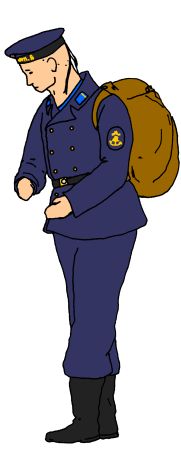
Figure 6
Artillerie Maat
Kiaochow Naval Artillery
Tsingtao 1914
Überzieher Jacket |

Figure 7
Matrose
Kiaochow Naval Artillery
Tsingtao c1910
Affenjacke Jacket |
| |
|
|
|
|
| |
Other Ranks Uniforms in
the Imperial German Navy
The uniforms of other ranks in
the Imperial German Navy were similar to those worn by most
European navies of the period. Blue uniforms were worn in
the Winter, while white uniforms were worn in the summer,
although photographs show that items of white and blue
uniforms were sometimes worn together. These standard
uniforms were worn at home in Germany and at sea, although
the focus of this page (and the
Naval Officers Page) is their use overseas and in China.
For variations on these uniforms worn in other theatres see
the pages on Naval
Landing Parties in the Tropics, the
Navy
in the Ottoman Empire and the
Navy on the
Western Front.
Headdress
Headdress consisted of a peakless naval cap either in white
or dark blue (see below). It had a small
imperial cockade above a black cap tally, the tails of which
were worn loose down the back. On the tally was
the name of the ship or unit to which the sailor was
attached (eg "S.M.S. JAGUAR", "GOUVERNEMENT KIAUTSCHOU" or "MATROSENARTILLERIE
KIAUTSCHOU") in metallic thread. Deck crew (the "Matrosen
Division"), such as
sailors and gunners wore yellow metallic thread, while
below-deck crew (the "Werft Division") such as
technicians, mechanics, craftsmen and stokers
wore white metallic thread from 1884 onwards. These
distinctions between Matrosen and Werft also appeared on
yellow or white metal buttons for jackets and thread on
embroidered insignia for all ranks.
Uniforms
There were three different types of naval shirt (the blue
woollen
shirt, the white shirt and the working shirt) and two types of
jacket (the blue double breasted jacket and the blue dress
jacket). These are photographed and described below.
Trousers for other ranks were either dark blue wool or
lightweight white and were usually worn loose over short
black leather jackboots.
NCO rank insignia was usually
worn in the form of chevrons on the left sleeve (in blue on
white uniforms and yellow (or white) metallic thread on blue uniforms),
while specialist insignia was usually worn in the form of
oval badges on the upper left sleeve bearing symbols of
their trade (again in blue on white uniforms and yellow
or white metallic thread on blue uniforms). This is of
course a vast simplification
of the topic of German naval insignia.
Blue Woollen Shirt |
|
|
|
The dark blue
woollen shirt ("Wollenes
Hemd"- see above) had plain gathered cuffs and a removable naval collar ("Exerzierkragen"
or often familiarly called a "Kieler Kragen" after the
port of Kiel) in a lighter shade of blue with three white
stripes around the edge. Under this collar was worn a black
neckerchief with a white tie. This was the uniform
most commonly worn by sailors of the Imperial German navy on
active service aboard ship or onshore during the Winter
months.
| |
|
| |
Figure 1 is based on a
photograph of a Sailor ("Matrose") of the Torpedo boat S-90 taken
in Tsingtao sometime before the First World War. During the
First World War the S-90 broke out of Tsingtao, attacked and
sank the Japanese cruiser Takachiho, evaded the
rest of the Japanese fleet and made for neutral
China, where the crew were interned at Nanking. This
sailor wears the blue woollen naval shirt and matching blue trousers worn loose over his boots.
He wears a
blue naval cap with "TORPEDOBOOT S-90" in gold or
white lettering around the
tally. Torpedo boat crews were distinguished by having red
piping around the naval cap. In a similar way U-boat crews
wore pink piping around their caps (see above)
Figure 2 is based on a
photograph of an First Class Gunner
("Artillerie
Ober-Matrose") of the
Kiaochow Naval Artillery
taken just after the Fall of Tsingtao in 1914. This
sailor wears the blue woollen naval shirt and matching blue trousers
tucked into his marching boots. He wears a blue naval cap
probably with "MATROSENARTILLERIE KIAUTSCHOU" in gold lettering around the
tally. Some cap tallies from the Kiaochow Batteries also had
the battery number on either side of the title, for example
"5. MATROSENARTILLERIE KIAUTSCHOU 5.". He has the single rank chevron of
an Ober-Matrose on his left sleeve.
|
White Shirt |
|
|
The
white cotton shirt ("Weißes
Hemd"- see above)
had blue cuffs with two white
stripes around the pointed upper edge and a single white
stripe along the lower edge. The naval collar of this shirt
was in a darker shade of blue with three white stripes
around its edges and was sewn into the shirt. Under
this collar was worn a black neckerchief with a white tie.
This was the uniform most commonly worn by sailors of the
Imperial German navy on active service aboard ship or
onshore during the Summer months or in tropical climates.
| |
|
| |
Figure 3 is based on a
photograph of a Sailor ("Matrose") of the SMS Jaguar
taken in
captivity in Japan in 1917. The gunboat SMS Jaguar
remained at Tsingtao during the siege then scuttled
herself when the German situation became hopeless. Her
crew were then taken as prisoners of war to Japan with
the rest of the Tsingtao garrison. This Matrose wears
the white uniform shirt with dark blue trousers and dark
blue cap with the "SMS JAGUAR" tally.
Figure 4 is
based on a photograph of a Sailor ("Matrose") of the
Kiaochow Naval Artillery taken in Tsingtao c1914. This Matrose wears
the white uniform shirt with matching white trousers and cap with the
Kiaochow Naval Artillery tally. |
Working Shirt |
|
|
Another type of white shirt was the working shirt ("Arbeitsbluse"-
see above).
It again was made of lightweight cotton with plain cuffs and
a single right breast pocket with no pocket flap.
It had a simplified sewn in naval collar in pale blue, again
with three white stripes around the edge. Under this collar
was usually worn a black neckerchief with a white tie. This
uniform was worn in hot weather for manual work.
| |
|
| |
Figure 5 is based on a
photograph of a First Class Gunner
("Artillerie
Ober-Matrose") of the
Kiaochow Naval Artillery taken in Tsingtao c1912. He wears
the white working
shirt with matching white trousers and cap with the
Kiaochow Naval Artillery tally. He has the single rank chevron of an Ober-Matrose on his left sleeve. |
Double Breasted Jacket |
|
|
In colder weather, other
ranks wore a woollen dark blue, double breasted jacket ("Überzieher" often referred
to as a "Collani" in naval slang, after the Berlin tailors Berger
& Collani who made many naval uniforms- see above). It had five
brass (or white metal for below-deck crew)
buttons down either side, with a crowned anchor on each. The
collar patches were blue (piped in red for torpedo boat crews).
NCO rank was displayed in thin yellow or white metallic bars across
the top edge of the collar patch.
| |
|
| |
Figure
6 is based on a
photograph of a Gunner of the Kiaochow Naval Artillery Batteries taken
just after the fall of Tsingtao in November 1914.
He wears the double breasted jacket and matching blue trousers
tucked into black jackboots.
Note the rank bar on his collar patch and the specialist
insignia in yellow metallic thread (see above) showing
him probably to have been an Artilleristen-Maat or an
Ober-Artilleristen Maat. Underneath his jacket he would
most likely be wearing a blue woollen naval shirt and
collar. He wears a blue naval cap
with the
Kiaochow Naval Artillery tally.
Note the
cap tallies hanging from the back of the cap.
He carries his kit and
possessions in a naval rucksack ("Seesack")
on his back (see above), these were sometimes decorated with unit insignia. As a prisoner of war he has been stripped of weapons and
ammunition and wears only his black leather naval belt with other ranks belt
buckle. During the siege many of the land based naval units would have been armed with the Mauser
Gew98 rifle and
would have carried 1909 ammunition pouches on their belts. |
Dress Jacket
|
|
|
| The Dress Jacket ("Affenjacke"-
see above)
was made of dark blue wool and had eight brass (or white metal)
buttons down either side, although it was actually loosely held
by a small chain between two additional buttons (see above). The
cuffs likewise had eight buttons. NCO rank was displayed by a
single chevron on the upper left arm for junior NCOs (see above
left) and lace on the cuffs for senior NCOs (see above right).
In the mid 19th Century the dress jacket had been standard wear for
Prussian (and later German) sailors, but the early twentieth
century
it was worn only on parade or for special occasions.
|
| |
|
| |
Figure 7 is based on a
photograph of a Gunner of the Kiaochow Naval Batteries taken in Tsingtao
sometime before the First World War. He wears the dress jacket
and white shirt with its dark blue naval collar. With these he
wears blue woollen trousers worn loose over his boots and a blue
naval cap with the
Kiaochow Naval Artillery tally.
Again note the cap tallies again hanging from the back of the cap. |
|
Period Photographs
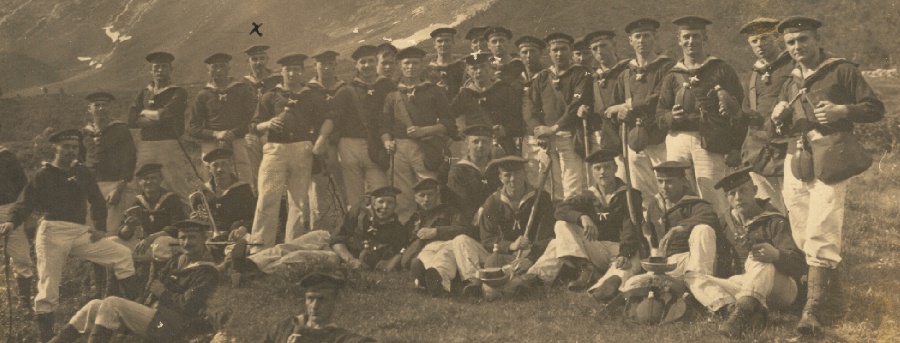
Sailors from a German Ship on Exercises
in the Mountains around Tsingtao
They wear blue naval caps and blue woollen shirts with white summer
trousers tucked ankle boots with leather gaiters. They carry water
bottles and naval bread bags. The letters SMS can just be made out on
their cap tallies showing they are from a ship rather than from the
naval base at Tsingtao but the ship's name cannot be read.
Photo ©
Joe Robinson
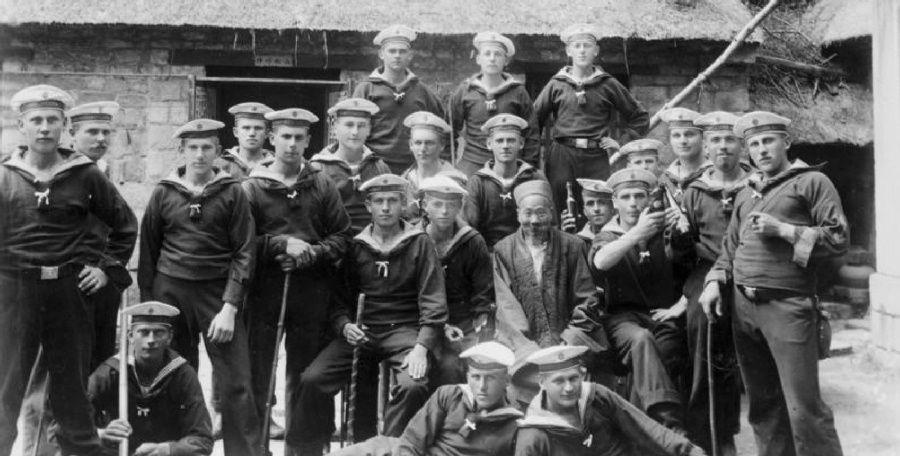
Naval Artillery near Tsingtao
They wear white naval caps and blue woollen shirts with matching
trousers worn loose over their ankle boots. From their cap tallies we
can just about make out that they are from one of the Kiaochow Naval
Artillery Batteries. Some have the other ranks naval belt buckle and
have water bottles.
Photo from Bundesarchiv/WikiCommons
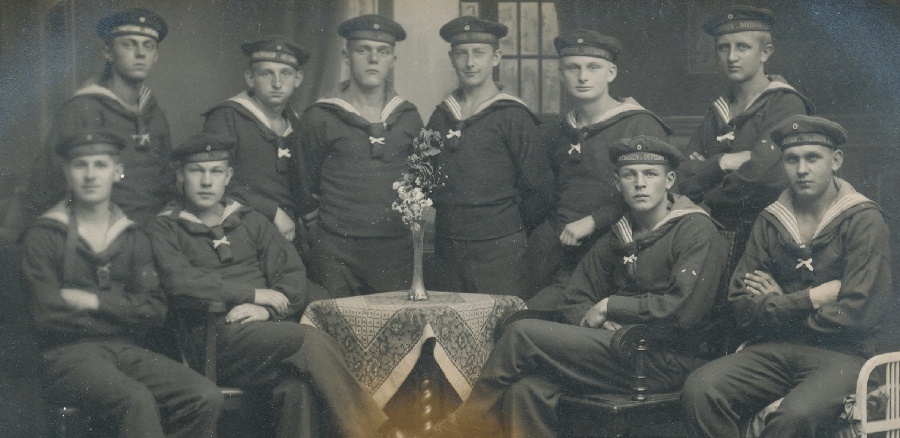
Sailors from a Matrosen Division in
Germany
They wear blue naval caps and blue woollen shirts with matching
trousers worn loose over their ankle boots. From their cap tallies we
can just about make out that they are from one of the Matrosen
Divisions. Three of the men (standing far right, seated second right and
seated far left) have signaller's specialist insignia just about visible
on their upper left sleeves. This is a dark blue oval with yellow
crossed flag poles, each bearing a red flag with a white central square
(the white white is all that can be seen on most of them).
Photo ©
Sam
Wouters
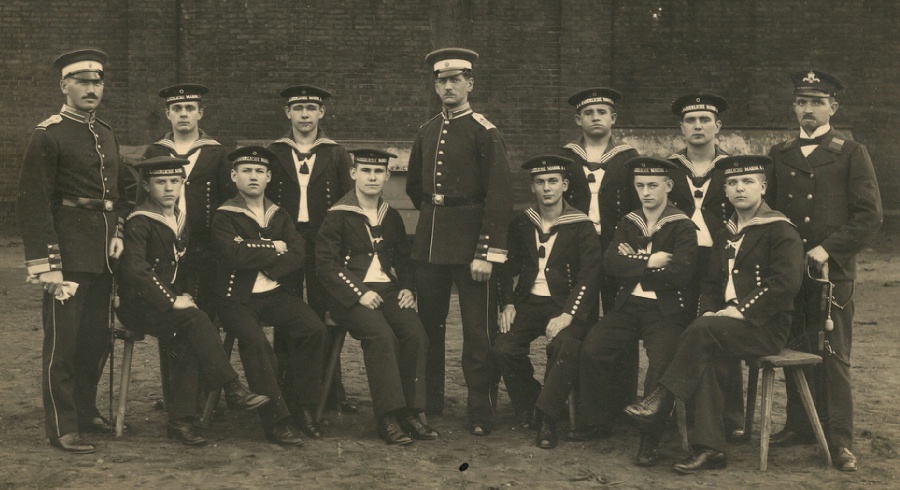
Staff of the Naval Clothing Depot in
Kiel, Germany
The NCOs on the left and in the centre wear the uniform of the I.
Seebataillon while the naval NCO on the right wears a double breasted
naval jacket. The other ranks wear dark blue naval caps with the tally
"KAISERLICHE MARINE", dark blue parade jackets ("Affenjacke")
over white naval shirts with the collar over the Affenjacke and dark
blue trousers loose over ankle boots.
Photo ©
Joe Robinson
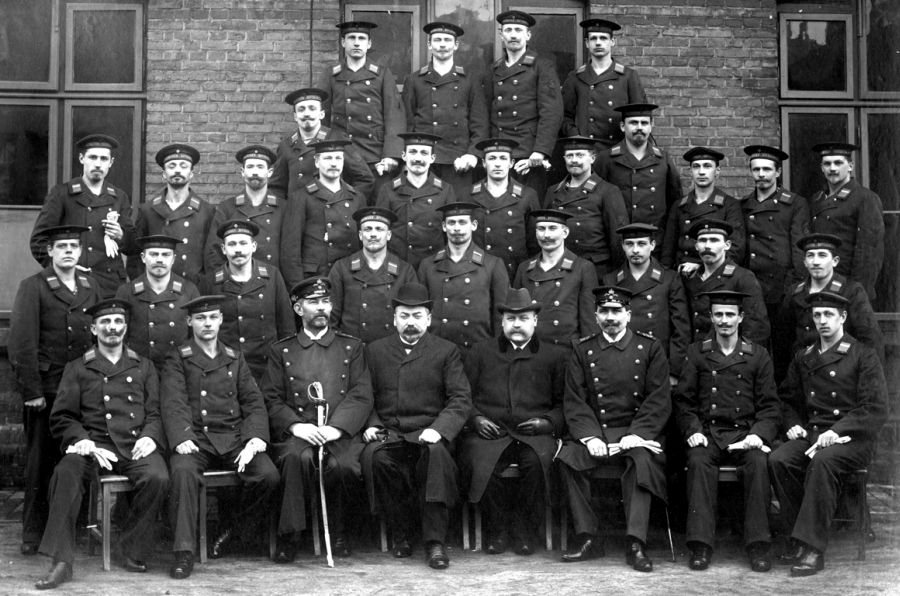
Sailors from the 1. Matrosen
Division in Germany
The other ranks wear dark blue naval caps and dark blue double
breasted jackets ("Überzieher").
The petty officers seated wear the officers double breasted coat. This
photograph was shared with us by Richard Cobb, the grandson of Walter
Kurze, a sailor in this photo. Kurze joined the Imperial Navy in 1895,
served in the Boxer Rebellion, was invalided out of service due to an
accident early in the First World War and emigrated to America in 1922.
There are four main rows in the photograph, and then two sailors between
the back (fourth) and third rows - Walter is the one on the left of
those two. Richard has a website with more of his grandfather's
interesting photographs at
Wind Drifter.
Photo ©
Richard Cobb
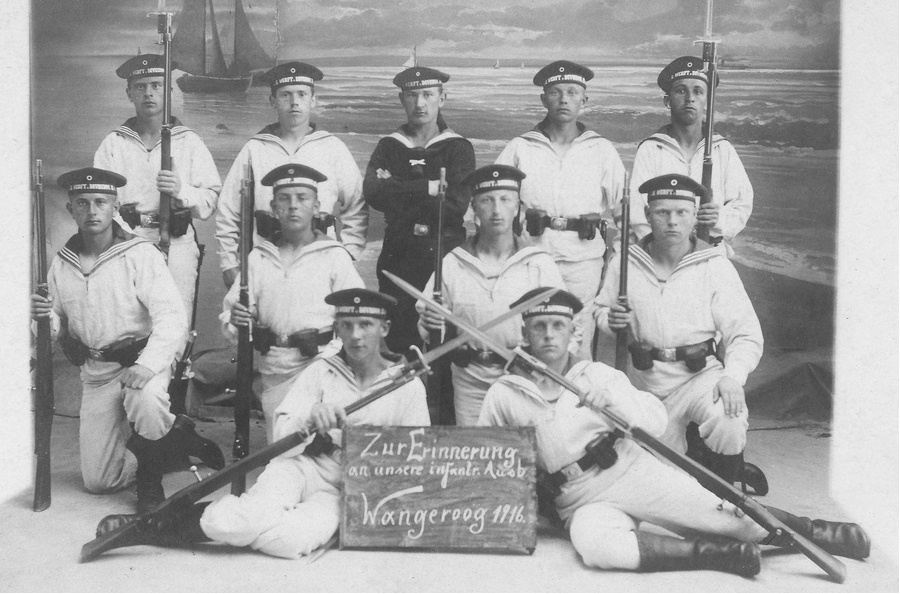
Sailors of the Recruitment Company
in Wangerooge on Germany's East Friesian Islands
They wear dark blue naval caps with tallies reading "II.WERFT.
DIVISION". The sailor in the centre wears a dark blue woollen uniform,
the reast wear the working shirt with its plain cuffs and single breast
pocket on the right. They wear white trousers with ankle boots and
leather gaiters. This unit far from the frontline in 1916 is armed with
out dated pre-1898 rifles and 1871 Hirschfanger bayonets.
Photo ©
Sam
Wouters
Recommended Reading
"Die deutschen Marinen 1818-1918: Organisation, Uniformierung,
Bewaffnung und Ausrüstung"
by Rolf
Noeske and Claus P. Stefanski
"Die Mützenbänder der Deutschen Marine 1815 - 1918" by Bernd Wedeking and
Markus Bodeux
"Unsere Marineuniformen" by J Zienert
Thanks to Johannes Sundermann for
his help on this page.
|